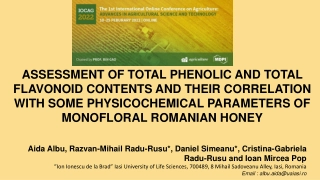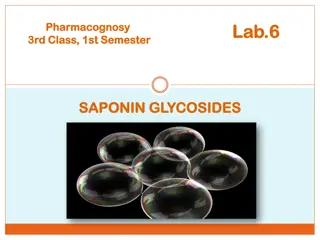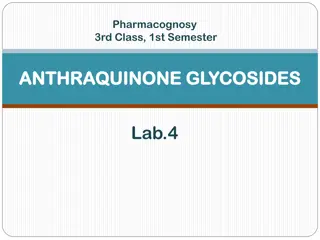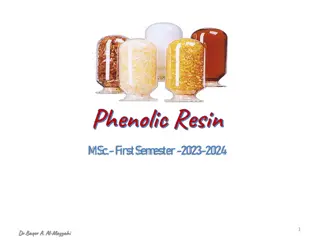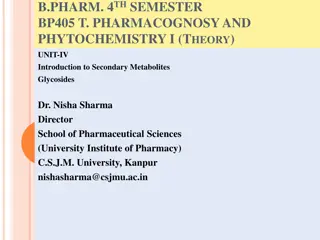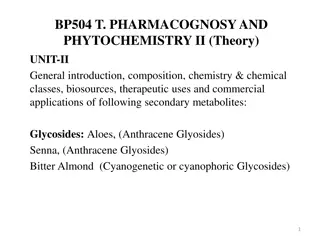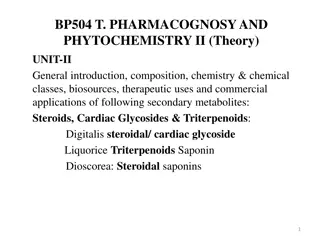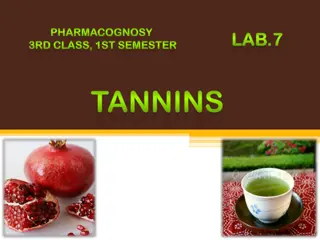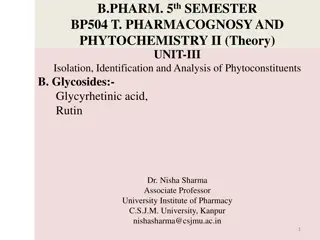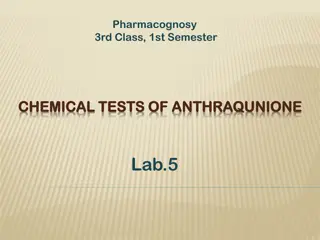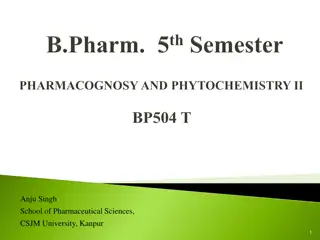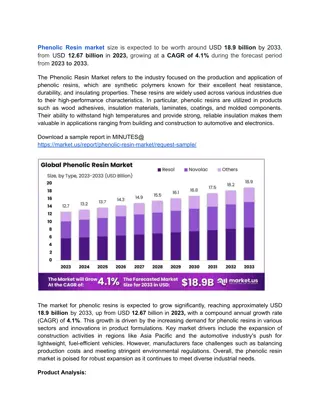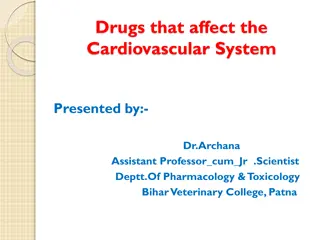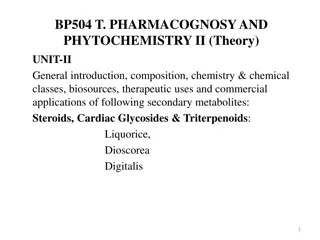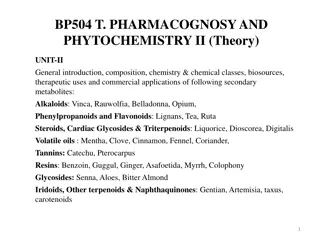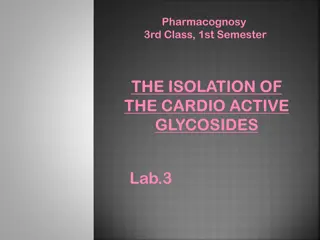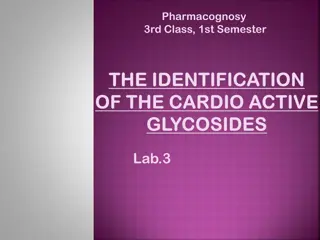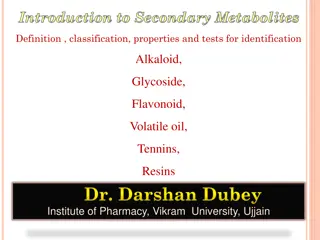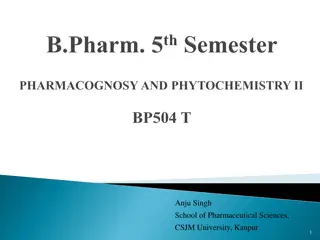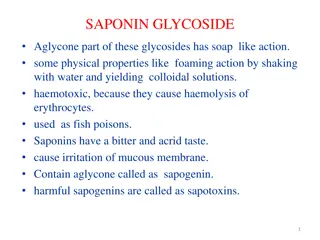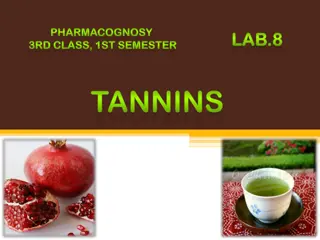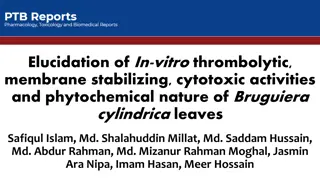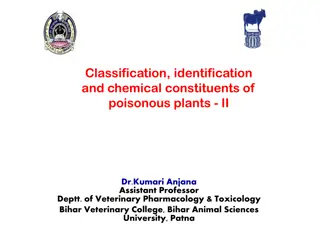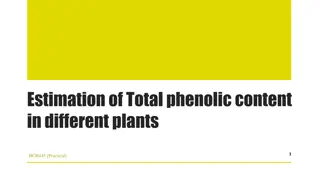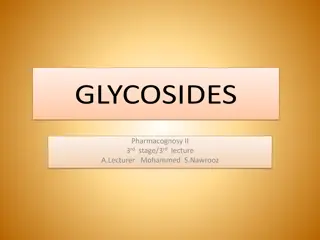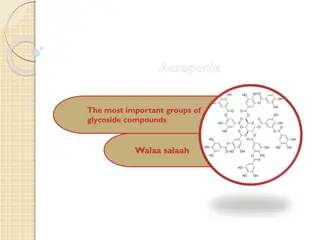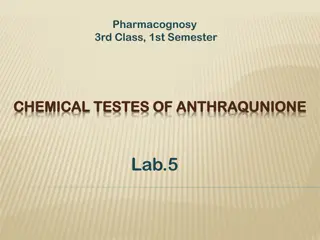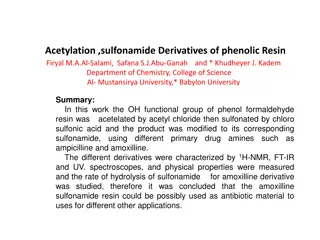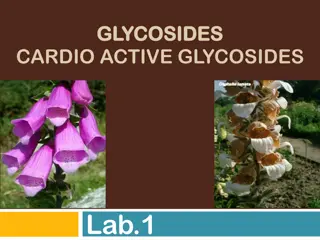Assessment of Total Phenolic and Total Flavonoid Contents in Romanian Monofloral Honey
Honey has been revered for its medicinal properties since ancient times, attributed to its antioxidant qualities. This study examined the total phenolic and flavonoid contents in various mono-floral honey samples from Romania and their correlations with different physicochemical parameters. The find
1 views • 15 slides
Identification of Cardioactive Glycosides in Pharmacognosy Lab Experiments
In this Pharmacognosy lab session, students learn about the identification of cardioactive glycosides through chemical tests like Baljets Test and Keller-Killians Test. These tests involve specific procedures using reagents like picric acid, sodium hydroxide, glacial acetic acid, ferric chloride, an
0 views • 11 slides
Understanding Saponin Glycosides in Pharmacognosy: Properties and Applications
Saponin glycosides, found in various plants, are compounds with diverse benefits ranging from cholesterol regulation to potential anticancer properties. They form colloidal solutions in water and are used in soap manufacturing due to their unique properties. Additionally, saponins have bitter taste,
7 views • 18 slides
Understanding Anthraquinone Glycosides: Pharmacognosy Insights
Anthraquinone glycosides are compounds found in medicinal plants like Senna, Cascara, and Aloe, known for their therapeutic actions. These glycosides are hydrolyzed to yield active aglycones, which act as stimulant cathartics by increasing smooth muscle tone in the colon. Market formulations and ext
1 views • 11 slides
ANTHRAQUINONE GLYCOSIDES Lab.4
Anthraquinone glycosides, found in certain plants, exert a stimulant cathartic effect by increasing smooth muscle tone in the colon. Administered orally, these compounds are hydrolyzed in the colon to active forms, providing relief from constipation. Long-term use of stimulant laxatives can lead to
0 views • 11 slides
Phenolic Resin
Phenolic resins, the oldest synthetic polymer, are produced by reacting phenols with aldehydes, primarily phenol and formaldehyde. This process was invented in 1907 and has since been crucial in manufacturing durable molded parts. Phenols, aromatic compounds with unique properties, play a key role i
1 views • 24 slides
Understanding Glycosides: Secondary Metabolites in Pharmacognosy
Glycosides are naturally occurring compounds with sugar and non-sugar components. They are characterized by glycosidic bonds and can be chemically separated. These compounds exhibit various physical and chemical properties, including solubility, taste, and optical activity. Classification based on g
1 views • 11 slides
Understanding Anthracene Glycosides in Pharmacognosy and Phytochemistry
Anthracene glycosides are secondary metabolites found in various plant families, offering therapeutic benefits. This comprehensive study explores their composition, chemistry, biosources, and applications, detailing the structural variations of aglycones and sugars present in these compounds. Method
0 views • 30 slides
Pharmacognosy and Phytochemistry II: Secondary Metabolites and Their Therapeutic Applications
This unit delves into the composition, chemistry, therapeutic uses, and commercial applications of secondary metabolites such as steroids, cardiac glycosides, and triterpenoids. It explores the properties of saponin glycosides, their classification based on aglycone nature, and the significance of s
0 views • 23 slides
Understanding Tannins: Properties, Uses, and Structures in Pharmacognosy
Tannins, complex phenolic glycosides found in plants, have various properties such as water solubility and ability to precipitate proteins. They are important for their astringency and therapeutic uses in tanning, treating burns, and as antioxidants. The interaction of tannins with macromolecules is
3 views • 18 slides
Isolation and Characterization of Glycosides: Glycyrrhetinic acid and Rutin
This study focuses on the isolation and analysis of phytoconstituents, mainly glycosides such as Glycyrrhetinic acid and Rutin. It explains the methods for extracting glycosides, purification techniques, and characterization using spectroscopy methods. The detailed procedures for isolating Glycyrrhe
1 views • 19 slides
Chemical Tests of Anthraquinone in Aloe Vera Extract
This laboratory experiment focuses on conducting chemical tests to identify anthraquinone glycosides in Aloe vera extract. The tests include Schoneten's reaction (Borax test) and Bromine test for aloin, providing specific reactions for the presence of these compounds. Additionally, special reagents
1 views • 12 slides
Understanding Saponin Glycosides in Pharmacognosy: Properties and Applications
Saponin glycosides are plant compounds with diverse applications, from forming colloidal solutions to binding with cholesterol in the body. They possess bitter taste and detergent-like properties, offering benefits in health and industry. Learn about their structures, sources like Quillaia saponaria
3 views • 18 slides
Overview of Secondary Metabolites: Alkaloids, Flavonoids, Steroids, and Glycosides
Exploring the diverse world of secondary metabolites, this content delves into the composition, chemistry, biosources, therapeutic uses, and commercial applications of various compounds such as Alkaloids, Flavonoids, Steroids, Glycosides, and more. It discusses the structural characteristics, biolog
0 views • 17 slides
Robust Expansion in Phenolic Resin Market Anticipated, Supported by Increased Us
Phenolic Resins Market By Product(Novolac, Resol, Other Products), By Application(Wood Adhesives, Insulation, Molding, Laminates, Coatings, Paper Impregnation, Other Applications), By End-use Industry(Building & Construction, Electrical and Electronics, Automotive, Lumber, Building and Construction,
0 views • 4 slides
Identification of Cardioactive Glycosides Through Chemical Tests
The laboratory experiments focus on identifying cardioactive glycosides through chemical tests like Baljets Test and Keller-Killians Test. These tests involve reactions with specific reagents to observe color changes and layer formations, helping in the identification of different parts of the glyco
2 views • 11 slides
Drugs Affecting the Cardiovascular System: Overview and Mechanisms
Explore the impact of various drugs on the cardiovascular system, including cardiac glycosides, vasodilators, anticoagulants, and more. Learn about the chemical nature and properties of glycosides and how they affect the heart's functioning.
1 views • 21 slides
Understanding Cardiac Glycosides in Pharmacognosy and Phytochemistry
Explore the role of Steroids, Cardiac Glycosides, and Triterpenoids in pharmacognosy and phytochemistry, focusing on their general introduction, composition, chemistry, biosources, therapeutic uses, and commercial applications. Learn about the structure and attachment of sugar parts in Cardiac Glyco
9 views • 9 slides
Overview of Indole Alkaloids in Pharmacognosy and Phytochemistry II
Indole alkaloids are a significant group of naturally occurring compounds with diverse chemical structures and physiological actions. This unit delves into the general introduction, composition, chemistry, biosources, therapeutic uses, and commercial applications of various secondary metabolites, in
0 views • 17 slides
The Biosynthesis and Role of Salicylic Acid in Plants
Salicylic acid (SA), a phenolic derivative widely present in plants, plays a crucial role as a regulator in various physiological and biochemical processes. Originally isolated from willow trees, SA is synthesized through the shikimate pathway via metabolic routes involving enzymes like PAL and BA2H
0 views • 10 slides
Isolation of Cardioactive Glycosides in Pharmacognosy Lab: Procedure and Results
In this pharmacognosy lab experiment, the aim is to isolate cardioactive glycosides from plant material using various equipment and reagents. The procedure involves maceration, extraction, and separation steps to isolate Fraction A containing the whole glycoside. The results indicate successful isol
0 views • 8 slides
Identification of Cardioactive Glycosides in Pharmacognosy Lab Experiments
The lab experiments focus on identifying cardioactive glycosides using chemical tests like Baljets Test and Keller-Killians Test, along with the identification of sterol glycosides through Raymmonds and Kedds reactions. These tests involve specific procedures with different reagents to observe color
0 views • 11 slides
Overview of Secondary Metabolites: Alkaloids, Glycosides, Flavonoids, and More
Secondary metabolites are chemical compounds produced by plants that have various biological effects. Alkaloids, a type of secondary metabolite, are organic compounds with nitrogen atoms and specific physiological actions. They exhibit diverse physical and chemical properties, making them essential
0 views • 63 slides
Exploring Secondary Metabolites in Ruta Graveolens for Therapeutic Applications
Delve into the world of secondary metabolites found in Ruta graveolens, commonly known as Rue or Garden Rue. Discover its rich composition of alkaloids, phenylpropanoids, flavonoids, steroids, cardiac glycosides, triterpenoids, volatile oils, tannins, resins, glycosides, iridoids, and other terpenoi
0 views • 13 slides
Understanding Saponins and Their Various Types
Saponins are glycosides with soap-like properties, used as fish poisons. They have foaming action and cause haemolysis. Two main categories are steroidal and pentacyclic triterpenoid saponins, distinguished by their aglycone nature. Steroidal saponins are essential for synthesizing various beneficia
0 views • 22 slides
Cardiotoxic Glycosides in Plants: Toxicity and Mechanism of Action - Overview
Plants like Nerium oleander, Thevetia peruviana contain cardiotoxic glycosides causing toxicity in animals and humans. Poisoning with these plants can be fatal, affecting the heart and nerves. Toxicity is mainly due to compounds like oleandroside and oleandrin, leading to cardiac failure and gastroi
0 views • 13 slides
Understanding Tannins in Pharmacognosy: Properties, Structure, and Uses
Tannins are phenolic compounds found in plants, known for their complex nature and diverse properties. They are soluble in various solvents, play a role in tanning leather, and have medicinal uses such as treating burns and acting as antioxidants. The interaction between tannins and macromolecules i
0 views • 18 slides
Study on Phytochemical Nature and Biological Activities of Bruguiera cylindrica Leaves
Investigation of phytochemical constituents and biological properties such as thrombolytic, membrane stabilizing, and cytotoxic activities of Bruguiera cylindrica leaves. Phytochemical screening revealed the presence of carbohydrates, glycosides, phenols, tannins, proteins, gums, and mucilages. The
0 views • 16 slides
Understanding Glycosides: Classification, Identification, and Toxicity in Poisonous Plants
Glycosides, ethers with a carbohydrate and non-carbohydrate moiety, are key toxicants in poisonous plants. Cyanogenic glycosides yield hydrocyanic acid, goitrogenic glycosides inhibit thyroid hormone production, while coumarin glycosides can lead to vitamin K deficiency. Steroid and triterpenoid gly
0 views • 25 slides
Comprehensive Analysis of Phenolic Board Manufacturers in Refrigerating and Air Conditioning Industries
This detailed analysis covers various aspects of phenolic boards used in refrigerating and air conditioning industries, including their physical properties, ignition tests, solubility, reactions with different chemicals, and specific tests. The content provides valuable insights into the characteris
0 views • 8 slides
Understanding the Role of Phenolic Compounds and Antioxidants in Health
Free radicals, oxidative stress, and the importance of antioxidants in combating these processes are discussed. Phenolic compounds found in plants have strong antioxidant properties, potentially aiding in the prevention of chronic diseases. The relationship between phenolic compounds, oxidative stre
0 views • 16 slides
Understanding Glycosides in Pharmacognosy: A Comprehensive Overview
Organic natural compounds known as glycosides are prevalent in plants and organisms, offering diverse therapeutic benefits. This article delves into the definition of glycosides, glycosidic linkages, and different types like O-, S-, N-, and C-glycosides, with examples from nature. The distinction be
0 views • 25 slides
Overview of Important Glycoside Compounds and Their Properties
Glycoside compounds play a significant role in various biological processes, with groups like steroids and cardenolides showcasing notable medicinal effects. Steroids are crystalline substances with specific solubility characteristics, while cardenolide glycosides are known for their toxic effects o
0 views • 13 slides
Chemical Tests for Anthraquinone in Aloe Vera Extract
This pharmacognosy lab experiment focuses on identifying anthraquinone glycosides in aloe vera extract through chemical tests like Schonteten's reaction with borax and the bromine test for aloin. Special reagents like nitric acid and nitrous acid are also used for specific identification. The proced
0 views • 12 slides
Acetylation Sulfonamide Derivatives of Phenolic Resin Study
Work conducted on modifying phenolic resin through acetylation, sulfonation, and sulfonamide formation using primary amines like ampicillin and amoxicillin. Characterization of derivatives was done using spectroscopic techniques, showing potential for antibiotic applications. Experimental processes
0 views • 15 slides
Understanding Glycosides: A Comprehensive Overview
Glycosides are compounds that undergo hydrolysis to yield sugar and non-sugar parts. The aglycone is also known as the genin, while the sugar part is the glycone. They are soluble in water and alcohols, with different solubility properties for glycone and aglycone parts. Glycosides can be hydrolyzed
0 views • 12 slides
